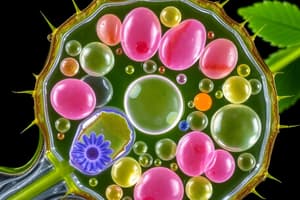Podcast
Questions and Answers
What is the function of lysosomes?
What is the function of lysosomes?
- Modify proteins
- Produce vital lipids
- Help in the digestion of food and removal of wastes (correct)
- Involved in secretion and intracellular transport
Which organelle is sometimes called 'suicidal bags'?
Which organelle is sometimes called 'suicidal bags'?
- Endoplasmic Reticulum
- Golgi Apparatus
- Lysosomes (correct)
- Nucleus
What is the main function of the Golgi Apparatus?
What is the main function of the Golgi Apparatus?
- Energy production
- Secretion and intracellular transport (correct)
- Protein manufacture
- Digestion of food
Which organelle is involved in protein manufacture?
Which organelle is involved in protein manufacture?
What is the role of smooth ER?
What is the role of smooth ER?
How do lysosomes contribute to a cell's health?
How do lysosomes contribute to a cell's health?
What is the main function of the nucleus in a cell?
What is the main function of the nucleus in a cell?
Which organelle is known as the 'powerhouse' of the cell?
Which organelle is known as the 'powerhouse' of the cell?
In which cells are mitochondria most plentiful?
In which cells are mitochondria most plentiful?
What is the primary function of chloroplasts in a cell?
What is the primary function of chloroplasts in a cell?
Which organelle within the nucleus serves as a template for protein synthesis?
Which organelle within the nucleus serves as a template for protein synthesis?
What distinguishes eukaryotic cells from prokaryotic cells regarding the presence of organelles?
What distinguishes eukaryotic cells from prokaryotic cells regarding the presence of organelles?
Study Notes
Cell Organelles: The Specialised Structures within Cells
Cell organelles are specialized structures present within cells that perform specific functions. These structures, much like organs in the body, help cells function efficiently and play a vital role in maintaining the cell's overall health. Let's explore some key cell organelles and their functions.
Nucleus
The nucleus, often referred to as the "command center" of the cell, is a large organelle found in eukaryotic cells. It stores the cell's DNA and controls all the cell's activities, such as growth and metabolism, using the genetic information in the DNA. Within the nucleus is a smaller structure called the nucleolus, which houses the RNA and serves as a template for protein synthesis.
Mitochondria
Mitochondria are often called the "powerhouses" of the cell. These oval-shaped organelles are found in most eukaryotic cells and serve as the site of cellular respiration, transforming molecules such as glucose into an energy molecule called ATP (adenosine triphosphate). They are most plentiful in cells that require significant amounts of energy to function, such as liver and muscle cells.
Chloroplasts
Chloroplasts, found in plant and some algae cells, serve as the site of photosynthesis. They contain the pigment chlorophyll, which captures the sun's energy to transform water and carbon dioxide into glucose for food. Chloroplasts allow autotrophic organisms to meet their energy needs without consuming other organisms.
Lysosomes
Lysosomes are single membrane-bound organelles filled with digestive enzymes. They help in the digestion of food and the removal of wastes and dead or damaged cells within the cell. They are sometimes referred to as "suicidal bags" because they can break down and digest various cellular components.
Endoplasmic Reticulum (ER)
The endoplasmic reticulum is a membranous organelle that shares part of its membrane with the nucleus. Some portions of the ER, known as the rough ER, are studded with ribosomes and involved with protein manufacture. The rest of the organelle, referred to as the smooth ER, serves to produce vital lipids.
Golgi Apparatus
The Golgi apparatus is involved in secretion and intracellular transport. It modifies proteins produced in the rough ER by adding sugar molecules, forming the mature proteins that are then transported to their final destinations within the cell.
Cell organelles play a crucial role in maintaining the cell's health and ensuring its proper functioning. They are essential for processes such as protein synthesis, energy production, and waste removal. Understanding these structures and their functions is fundamental to understanding cell biology and the workings of living organisms.
Studying That Suits You
Use AI to generate personalized quizzes and flashcards to suit your learning preferences.
Description
Test your knowledge of cell biology by exploring the functions and structures of key cell organelles such as the nucleus, mitochondria, chloroplasts, lysosomes, endoplasmic reticulum, and Golgi apparatus. Learn about their roles in processes like DNA storage, energy production, protein synthesis, and waste removal.



